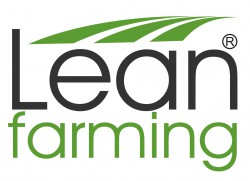This post is also available in:
 Danish
Danish
Do you focus on efficiency? Then you need to start creating flow in the production. A stable flow with regular weekly groups is fundamental to creating efficiency.
How to make a flow chart
I have made an example of a production flow in a herd of 1000 cows. I have outlined the absolutely perfect flow with exactly the same group size every week. That’s not the reality at all and not at all in the beginning, but it’s the perfect plan to strive for. Number of animals being moved each week are just examples. When you make your own flow chart, you have to include your own numbers. I show here how. You need to make it to fit your barn and your production numbers for reproduction and health.
In my example, there are 22 calvings per week, i.e. 1144 per year. I have calculated a replacement percentage of 40, so it gives a need for 8 close-up heifers and 14 dry cows every week. as you can see on the map, in fact only 21 fresh cows go over to the farm with milk production, but that is because I have taken into account that one of the cows is culled shortly after calving and thus as such will not go as a milking cow. From the milking facility, 7 cows are culled every week.
The number of heifers each week is your pacemaker process
From the heifer barn, one is culled every week, but x number for sale for living use. I also make a flow chart for heifer production, but that’s not included here. The most important thing is that the production is organized so that it can deliver 8 super close-up heifers every week, which are of good milk production breed, have the right weight and are healthy with good legs. This is what we call the pacemaker.
8 good close-up heifers at a steady pace each week is the pacemaker that determines the pace of production. It is in the same way as with the heartbeats, which should preferably come in a steady rhythm. Hence the term pacemaker process. When you are going to work on getting regular weekly groups, then you need to start with your pacemaker process. It is not always the heifers, but can also be the number of calvings per. week for example. The pacemaker process is often where you have your bottleneck. This is where the plant has its limitation, the rhythm is determined.
In my example, it is the heifers that determine the rhythm. If the number of heifers fluctuates each week, then the entire production fluctuates up and down. It puts pressure on some barn sections in periods. Sometimes you cannot move animals at the right time because there is no place to move them. The calf huts are pressed and can not be washed, in the calving box there are too many animals and this gives health problems and more work. When the tact is the same and the production runs in a fixed rhythm, then you can much better make it all fit together. You also know how many hours production requires each week. It provides calmness because it is predictable.

How to get started
- What is the limitation of the plant? It can e.g. be the number of milking cows because it is determined by the number of cubicles. How many milking cows are optimal for you?
- You know the culling rate in the herd, so therefore you can also calculate how many heifers you need per year.
- By dividing that number by 52, you get the optimal number of heifers you need to have in the herd each week.
- From here you can calculate all the other numbers such as. number of culling each week, number of calvings each week, etc.
- It is possible that your facility in some sections will have to be divided or expanded if you are to keep the groups together. If you have X dry cows and Y close-up heifers every week for calving, then it is an advantage if your plant has boxes that correspond to that number.
- Once you have drawn the optimal flow diagram, you can start planning how the production should be to keep that pace. There are probably some variations over the year that you should level out. The tools you have for this are:
- When to sell excess heifers and cows for culling
- How to use sexed semen and beef semen
- When to inseminate heifers and cows
- When do you dry off the individual cows
- How good stability you have in insemination rate, pregnancy rate and start-up of fresh cows.
- You will probably need to constantly adjust over the next few months to achieve a smooth flow. It takes some time and must be followed closely on a large visible board so that everyone can follow it.
- It is necessary that you do not use “passive” breeding plans i.e. with e.g. 30% beef cattle for all cows or sexed semen for all heifers. You must actively choose which animals you want to inseminate with what and when. Then you are sure that you have the right number of lose-up heifers ready every week all year round.
I am completely convinced that once you have run a period of regular weekly groups, you will experience calmness and stability that can be felt. If you want any help to get started, contact me. I want to help.




